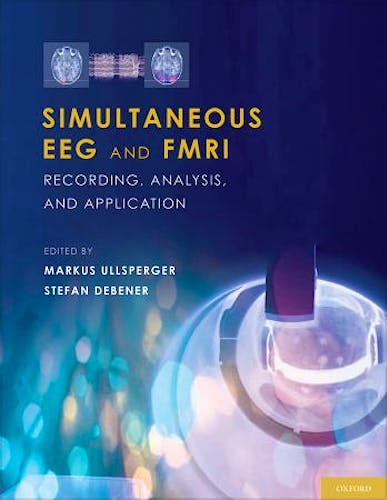

No hay productos en el carrito



Simultaneous EEG and FMRI. Recording, Analysis, and Application
Ullsperger, M. — Debener, S.
1ª Edición Junio 2010
Inglés
Tapa dura
336 pags
1000 gr
17 x 24 x 2 cm
ISBN 9780195372731
Editorial OXFORD UNIVERSITY PRESS
LIBRO IMPRESO
Oferta
-5%
173,32 €164,65 €IVA incluido
166,65 €158,32 €IVA no incluido
Recíbelo en un plazo de
2 - 3 semanas
Description
• Conferences: OHBM, SfN, Meeting of the Federation of European Neuroscience Societies, Trends in Cognitive Sciences, World Congress of Psychophysiology, Society for Psychophysiological Research Journals: Neuroscience, Trends in Neurosciences, Nature Reviews Neuroscience, Nature, Clinical Neurophysiology, Neurology and Neuroscience Journals Export markets: Germany, The Netherlands, UK, Australia
• Selling point: The emphasis of the book will be directed toward optimal ways of analyzing and integrating the data from the different modalities
• Selling point: will provide the reader with details on how to set up a lab allowing simultaneous recordings
• Selling point: The great strength in simultaneous recordings lies in the opportunity to investigate dynamic processes, e.g., on a single-trial basis or in ongoing activity.
• Selling point: will provide the reader with tools for state-of-the-art data analysis
• Selling point: discusses future uses of this new technique
One of the major challenges in science is to study and understand the human brain. Numerous methods examining different aspects of brain functions have been developed and employed. To study systemic interactions brain networks in vivo, non-invasive methods such as electroencephalography (EEG) and functional magnetic resonance imaging (fMRI) have been used with great success. However, each of these methods can map only certain, quite selective aspects of brain function while missing others; and the inferences on neuronal processes and information flow are often rather indirect. To overcome these shortcomings of single methods, researchers have attempted to combine methods in order to make optimal use of their advantages while compensating their disadvantages. Hence, it is not surprising that soon after the introduction of fMRI as a neuroimaging method the possibilities of combinations with EEG have been explored.
This book is intended to aid researchers who plan to set up a simultaneous EEG-fMRI laboratory and those who are interested in integrating electrophysiological and hemodynamic data. As will be obvious from the different chapters, this is a dynamically developing field in which several approaches are being tested, validated and compared. Currently, there is no one best solution for all problems available, but many promising techniques are emerging. This book shall give a comprehensive overview of these techniques. In addition, it points to open questions and directions for future research.
Readership: Cognitive neuroscientists, experimental psychologists, neurophysiologists, researchers, neurologists, neurosurgeons, Residents in neurology
• Conferences: OHBM, SfN, Meeting of the Federation of European Neuroscience Societies, Trends in Cognitive Sciences, World Congress of Psychophysiology, Society for Psychophysiological Research Journals: Neuroscience, Trends in Neurosciences, Nature Reviews Neuroscience, Nature, Clinical Neurophysiology, Neurology and Neuroscience Journals Export markets: Germany, The Netherlands, UK, Australia
• Selling point: The emphasis of the book will be directed toward optimal ways of analyzing and integrating the data from the different modalities
• Selling point: will provide the reader with details on how to set up a lab allowing simultaneous recordings
• Selling point: The great strength in simultaneous recordings lies in the opportunity to investigate dynamic processes, e.g., on a single-trial basis or in ongoing activity.
• Selling point: will provide the reader with tools for state-of-the-art data analysis
• Selling point: discusses future uses of this new technique
One of the major challenges in science is to study and understand the human brain. Numerous methods examining different aspects of brain functions have been developed and employed. To study systemic interactions brain networks in vivo, non-invasive methods such as electroencephalography (EEG) and functional magnetic resonance imaging (fMRI) have been used with great success. However, each of these methods can map only certain, quite selective aspects of brain function while missing others; and the inferences on neuronal processes and information flow are often rather indirect. To overcome these shortcomings of single methods, researchers have attempted to combine methods in order to make optimal use of their advantages while compensating their disadvantages. Hence, it is not surprising that soon after the introduction of fMRI as a neuroimaging method the possibilities of combinations with EEG have been explored.
This book is intended to aid researchers who plan to set up a simultaneous EEG-fMRI laboratory and those who are interested in integrating electrophysiological and hemodynamic data. As will be obvious from the different chapters, this is a dynamically developing field in which several approaches are being tested, validated and compared. Currently, there is no one best solution for all problems available, but many promising techniques are emerging. This book shall give a comprehensive overview of these techniques. In addition, it points to open questions and directions for future research.
Readership: Cognitive neuroscientists, experimental psychologists, neurophysiologists, researchers, neurologists, neurosurgeons, Residents in neurology
© 2025 Axón Librería S.L.
2.149.0